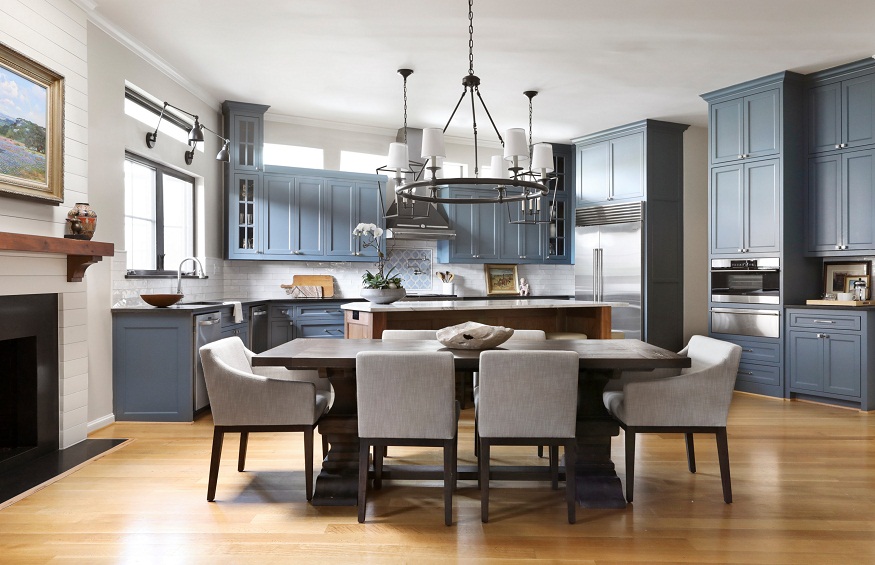In modern homes, the trend of combining the kitchen and dining room has gained immense popularity. This layout not only maximizes space but also fosters a more communal and interactive atmosphere. If you’re considering this design for your home, working with an interior designer and focusing on modular kitchen elements can create a seamless and stylish space.
The Benefits of a Combined Kitchen-Dining Room
A combined kitchen-dining room offers numerous advantages:
- Open Space: Removing walls between the kitchen and dining areas creates an open, airy environment that makes the space feel larger and more inviting.
- Enhanced Interaction: This layout allows for better interaction between family members and guests. Cooking becomes a more social activity when it’s integrated with the dining area.
- Increased Functionality: Combining these spaces can increase functionality, as it simplifies serving meals and cleaning up afterward.
Planning Your Combined Kitchen-Dining Room
Engage an Interior Designer
An interior designer can help you make the most of your space. They bring a wealth of knowledge about current trends, efficient layouts, and optimal use of materials.
Consider Modular Kitchen Solutions
A modular kitchen is a highly customizable setup comprised of standardized units or modules. These are designed to maximize utility and enhance the aesthetics of your kitchen. Modular kitchens offer several benefits:
- Flexibility: Easy to assemble and disassemble, making renovations and changes simpler.
- Efficiency: Designed to optimize the use of space and improve functionality with cleverly integrated storage solutions.
- Style: Available in a variety of designs, finishes, and colors to suit any taste.
Key Elements to Include
1. Unified Aesthetic
A cohesive aesthetic is crucial for a combined kitchen-dining space. Here are some tips:
- Color Scheme: Choose a color palette that harmonizes both areas. Neutral shades with pops of color can create a balanced and visually appealing look.
- Materials: Consistent use of materials, such as matching countertops, cabinetry, and flooring, can unify the space.
- Lighting: Use a mix of ambient, task, and accent lighting to highlight different zones while maintaining a consistent style.
2. Efficient Layout
The layout should facilitate easy movement and interaction. Some popular layouts include:
- L-Shaped: Utilizes two adjacent walls, offering ample counter space and keeping the cooking area compact.
- Island: An island can serve as a bridge between the kitchen and dining areas, providing extra workspace and a spot for casual dining or socializing.
- Peninsula: Similar to an island but connected to one wall, creating a natural partition while maintaining an open feel.
3. Functional Zones
Divide the space into functional zones to ensure efficiency:
- Cooking Zone: Includes the stove, oven, and other appliances. Ensure this area has sufficient ventilation.
- Prep Zone: Located near the cooking area, with plenty of counter space for meal preparation.
- Cleaning Zone: Includes the sink and dishwasher. Position this area near the cooking zone for convenience.
- Dining Zone: Should be easily accessible from the kitchen. Opt for a dining table that complements the kitchen design and is proportionate to the space.
Incorporating Smart Solutions
Technology can enhance the functionality and comfort of your combined kitchen-dining room:
- Smart Appliances: Invest in energy-efficient, smart appliances that can be controlled remotely.
- Integrated Storage: Hidden storage solutions can keep the space clutter-free and maintain a streamlined appearance.
- Multifunctional Furniture: Consider furniture that serves multiple purposes, such as extendable dining tables or benches with storage.
Final Thoughts
A thoughtfully designed combined kitchen-dining room can transform your home into a hub of activity and enjoyment. By incorporating modular kitchen elements and working with an experienced interior designer, you can create a space that is both functional and aesthetically pleasing. Whether you’re hosting a dinner party or enjoying a quiet family meal, this integrated space will enhance your home life. For more inspiration and tips, refer to a comprehensive dining room plan.
For more tips and inspiration, consider consulting with a professional interior designer who can tailor the space to your specific needs and preferences.

